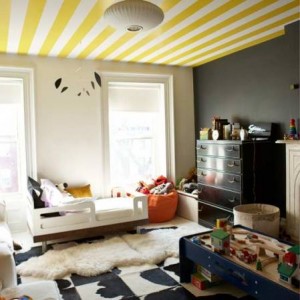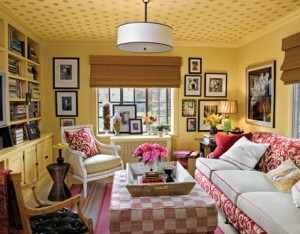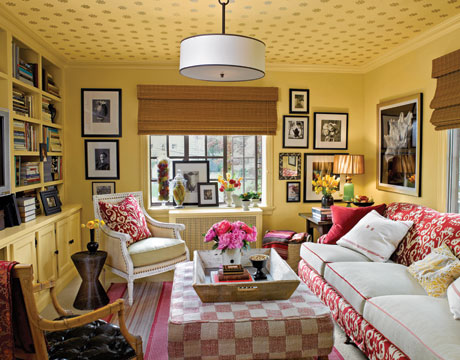Ceilings, more often than not, are the most boring element of a room’s design; by far. For some reason, we tend to think of ceilings as not being a part of the room when it comes to design.
Now, for homes with beamed, coffered and tray ceilings, this is not the case. But for the majority of homes, that is the exception and not the rule.
Well, don’t neglect your ceilings any longer. here’s what you can do:
Paint It

As with any of the other four walls, the quickest and simplest way to alter the design of the ceiling is to paint it. While the standard is for ceilings to be painted white, this adds absolutely zero visual interest to the room.
If the thought of painting a ceiling seems unconventional enough, then it may be best to steer clear of the stripes and patterns. That is, at least until the idea of a painted ceiling as had some time to grow on you.
In the meantime, pick out an accent color from the room in which the ceiling is to be painted. Now find that color, but 3-4 shades lighter. This muted tone adds depth to the room without being a distraction.
Wallpaper
Technically speaking, a ceiling can be considered a wall. After all, it confines you to a certain area just as any vertical wall would. So treat it like any other wall and wallpaper it.

The thought of wallpapering a ceiling probably sounds absurd at first thought, but it seems no more outrageous than painting it. Successfully wallpapering a ceiling typically undergoes the same considerations as applying it to vertical walls. Try to find a wallpaper that will compliment the design style of the home (florals for traditional designs, bold geometric patterns for modern designs, etc.) and brings out the more subtle design elements in a room.
Combinations

When in doubt, try mixing it up. Certain individual elements that work well for ceiling design also play well together. For example, deep coffered ceilings would pair well with painted patterns or wallpaper because the deep trim acts as a frame for the patterns. When adhering to the rules of finding complimentary colors and patterns, combinations like this one can have a dramatic effect on the room’s design.
Tray ceilings also lend themselves well to this combo design approach. Try leaving the two horizontal surfaces white and applying an alternate color or pattern to the vertical portion for a unique effect.
—
Start looking at your ceiling as the fifth wall and include it in the plans for the next design update. Some ceiling design updates are quick and easy to apply while others require a bit of construction. However, all of them should be considered.

